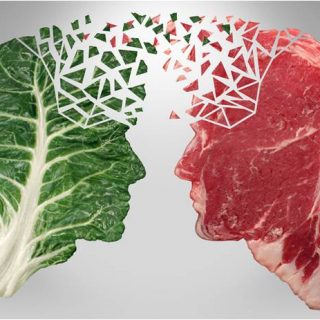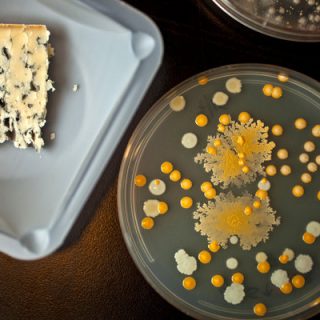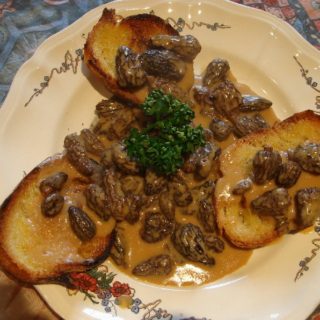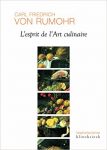
Œuf en meurette
French gastronomy, so highly regarded worldwide, does put substantial emphasis on meat, especially for main courses. Coq au Vin, Pot au Feu, Beef Bourguignon and Steak Chateaubriand are famous dishes, and famously meaty. Whether at restaurants or in canteens, avoiding meat in France is, as Sandra Haurant in The Guardian put it, ‘a tricky business’.
Yet many traditional French dishes are in fact vegetarian: why don’t we see more of them on menus? One of the joys of French cuisine is its regional diversity. It would be great for both French people and foreign visitors to enjoy regional vegetarian dishes along with the lovely French accompaniments: bread, cheese, desserts, and of course, wine. It could even be a canny choice for chefs and restaurateurs to put a vegetarian dish on the menu, as they are often cheaper to prepare than meat dishes.
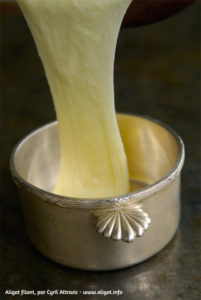
Aligot
Being a vegetarian in France can feel like a pleasure and a pain. There is the pleasure of the fantastic diversity and quality of vegetarian ingredients: the fruit, vegetables, cheese, bread, pastries, and so on. But look at the menu of a typical French restaurant and the pain is the lack of vegetarian options, especially in the ‘formules’ or set menus that are so popular at lunchtime.
So why don’t we go on a little ‘Tour de France’ of vegetarian dishes? Many more could be added to this list. Dishes with eggs and cheese are included, those with fish are excluded. Some of those listed may appear on menus as side dishes but, crucially, it is also possible for them to be served as main courses in their own right or dressed with other ingredients.
Tour of French Vegetarian Dishes (with links to recipes in French)
Central and Southern France:
- L’Aligot ( a hot dish of mashed potatoes, cheese and garlic, from the Aveyron region)
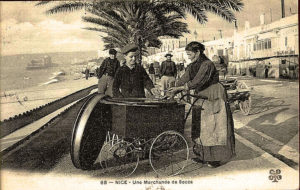
Marchande de socca
- La Cervelle de Canuts (a creamy dish made with fromage blanc or goats cheese and herbs, garlic and onion, from Lyons)
- Bajana (a warming soup made with chestnuts and sometimes vegetables, from the Ardèche and Cévennes)
- La Crique (a potato pancake, from the Ardèche and Drôme)
- Le Crespeou (a magnificent layered omelette with vegetables and herbs, from Provence)
- Le Papeton d’aubergine (aubergine pâté, often sliced and served with salad, from Avignon)
- La Socca (a chickpea pancake from Nice and Menton; long available as street food (see image below) )
- Miggliaciu (a sort of baked cheese pancake from Corsica )
Eastern France :
- La Croûte aux Morilles au Vin Jaune (crusty bread soaked in a creamy mushroom and wine sauce from Franche-Comté)
- La Soupe de Mai (a hearty soup made with pasta crozets and vegetables, from the mountainous Savoy region)
- Le Berthoud savoyard aux pommes de terre (Abondance cheese and white wine baked together and served with potatoes in their skins, from Savoy)
- La Péla (Abondance cheese and white wine baked together and served with potatoes in their skins, from Savoy)
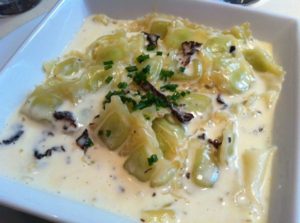
Ravioles du Royans
- Les Gaudes (a sort of corn pudding or pancake from Burgundy and the Bresse region)
- Oeufs en meurette (Eggs poached in a red wine sauce, from Burgundy and also served in Lyons; bacon may be used in the sauce, however)
- Ravioles du Royans (Cheese and parsley ravioli from the Isère Valley)
- Zewelkueche (an onion tart from Alsace)
Northern and Western France:
- La Tarte au Maroilles or Flamiche au Maroilles (a kind of baked Maroilles cheese tart, sometimes made with cream and eggs, from Picardy)
- Oeufs brayons (a baked duck egg omelette from Normandy)
- Pâté de pommes de terre/Tourte berrichonne (a sort of potato pie from the Bourbonnais/Berry region)
- Le Tourteau fromagé (a sort of cheese pancake or pie from Haut-Poitou)
And all of this is without even mentioning the omelettes, galettes, raclettes, ratatouilles, oeufs en cocotte, gratins, fougasses and quiches that are widely known, quintessentially French and very often prepared without meat. Eating well in France doesn’t always have to mean meat as a main course: bon appétit!
Rory Hill is a British geographer and a research scholar at the Food 2.0 LAB ; his works focuses on French terroir.





